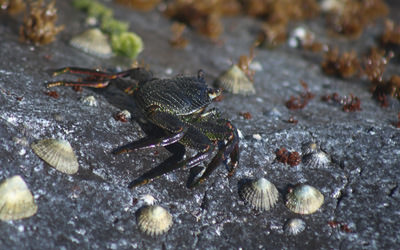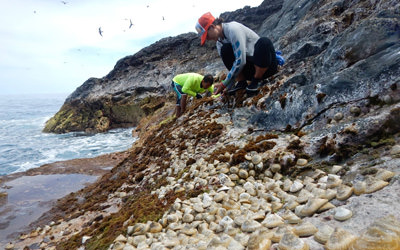Scientists Monitor ‘Opihi and other Intertidal Species in Papahānaumokuākea

On September 25, scientists aboard the research vessel M/V Searcher returned to Oʻahu after monitoring ‘opihi populations and other rocky intertidal organisms in Papahānaumokuākea Marine National Monument. This year marks the ninth annual intertidal monitoring expedition, which integrates cultural knowledge and practices with western science to assess and better understand the shorelines and shallow waters of high islands within PMNM.
Participants surveyed Nihoa, Mokumanamana, La Perouse Pinnacle at French Frigate Shoals, and Gardner Pinnacles. This ongoing research, led by members of the ‘Opihi Partnership, a public-private collaborative partnership consortium, continues to provide managers with insights into how to make better-informed management decisions concerning harvesting of intertidal species in the main Hawaiian Islands.
Team members had about two days to survey the intertidal areas at each site, engaging in a wide range of protocol addressing natural as well as cultural health and wellness. One focus of the expedition was to determine what proportion of ‘opihi (Hawaiian limpet) populations are actually spawning at this time of year. ‘Opihi is a Hawaiian delicacy and culturally important species whose numbers have been dwindling in the Main Hawaiian Islands due to overharvesting. This research aims to help develop sustainable harvest protocols over time.
In addition, this year participants conducted the first rigorous scientific investigation of the limu (algae) along the rocky intertidal habitats in the Monument. A phycologist (limu specialist) from the Waikīkī Aquarium was on board to lead this work.

Nā Maka o Papahānaumokuākea, a Hawaii-based nonprofit organization, led Huli‘ia, a method to collect detailed, holistic observations based on traditional knowledge systems that build intimate knowledge of the surrounding environment. The creation of seasonal calendars is one product born from Huli‘ia where connections are drawn on between dominant patterns in the atmosphere, land and ocean. It is a collaborative effort to strengthen place-based knowledge and re-establish healthy relationships between people and place.
Members of the expedition also included staff from NOAA and the University of Hawai‘i as well as representatives of coastal communities involved in sustainably managing their own ‘opihi stocks.



